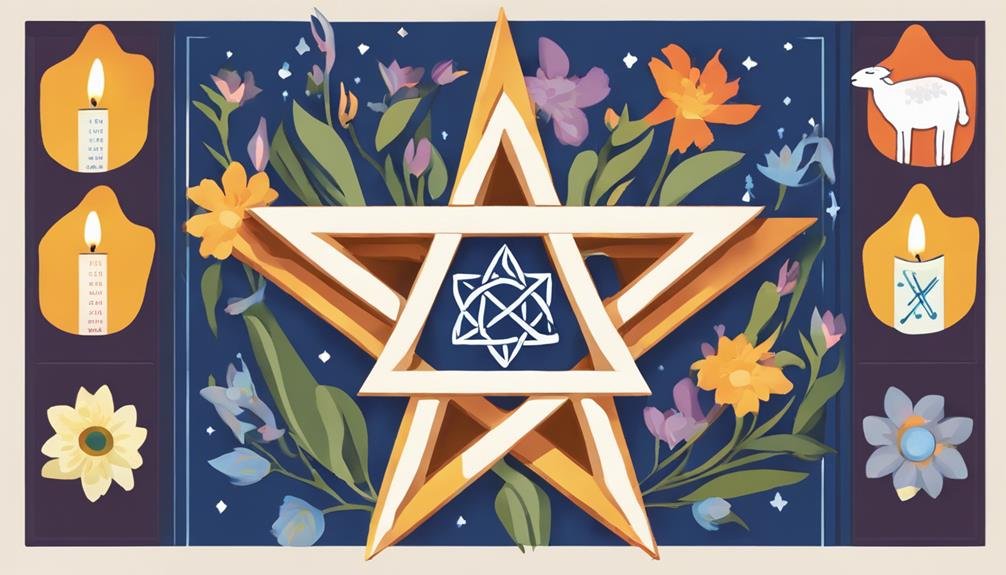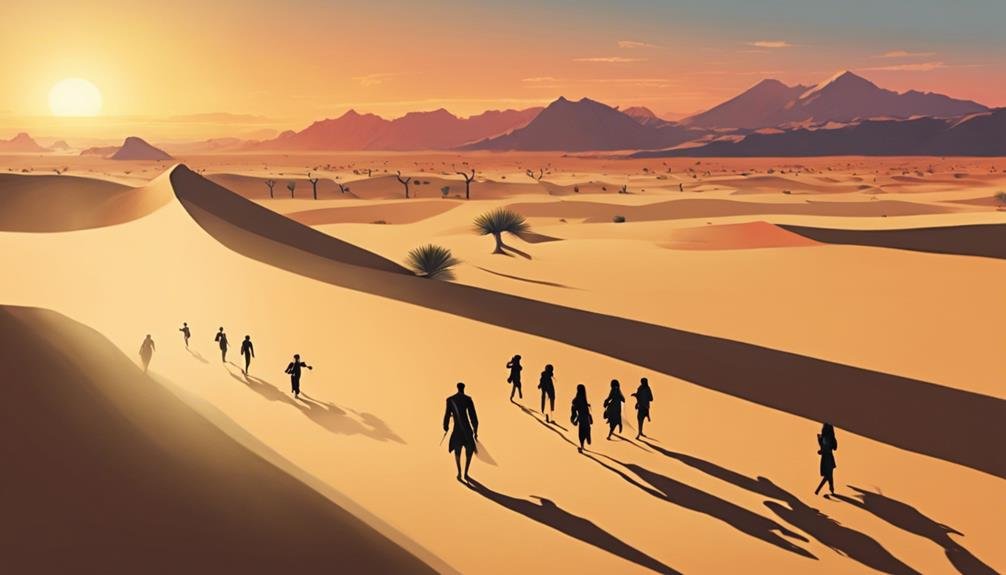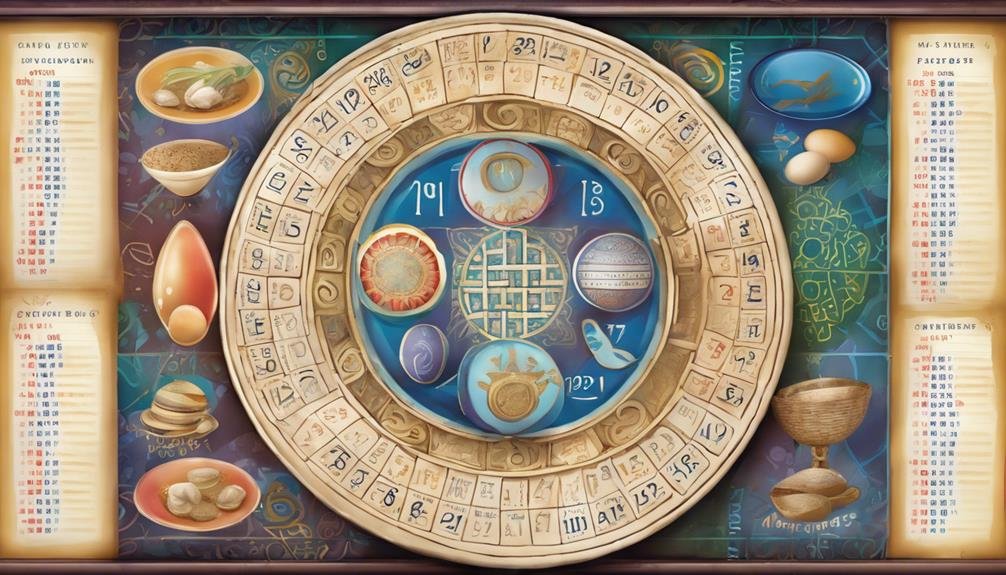You might wonder why Passover and Easter often seem to fall around the same time each year. It’s not just a coincidence but a captivating intersection of lunar calendars and historical events. Passover commemorates the Israelites’ escape from Egyptian bondage, while Easter celebrates Jesus’ resurrection. The Last Supper is believed to have been a Passover seder, linking these holidays even further. This overlap underscores themes of freedom and redemption in both traditions. But what determines their timing, and how have their observances evolved over the centuries?
Key Takeaways
- Passover and Easter follow lunar calendars, causing their dates to vary yearly.
- The holidays often overlap due to their reliance on lunar cycles.
- Passover and Easter are linked historically through the Last Supper, believed to be a Passover seder.
- Both holidays symbolize themes of freedom and redemption, contributing to their interconnected observances.
- Easter and Passover share cultural and historical significance, often leading to concurrent celebrations.
Reasons for Overlap

The overlap between Easter and Passover happens because both holidays are tied to lunar calendars. The Christian liturgical calendar determines Easter, while Passover follows the Jewish calendar. Both calendars rely on lunar cycles, meaning their dates can vary yearly. This shared reliance on lunar calendars is why Easter and Passover often coincide.
Since 2000, Easter and Passover have coincided every year but four, underscoring their close alignment. However, differences in rules and calculations between the two holidays can lead to occasional misalignment. For instance, the Christian liturgical calendar uses the Gregorian calendar to determine the date of Easter, the first Sunday after the first full moon following the vernal equinox.
On the other hand, the Jewish calendar sets Passover to begin on the 15th of Nisan, following its own specific rules. The alignment of Easter and Passover highlights the historical significance of both holidays, as they share a deep-rooted connection in history. Additionally, this overlap holds cultural importance, allowing communities to recognize and celebrate their intertwined heritage. However, when misalignment occurs, it reminds us of the distinct traditions and calculations that define each holiday.
The Last Supper
Traditionally, many believe the Last Supper was a Passover seder where Jesus and his disciples gathered to celebrate in Jerusalem. This meal holds immense cultural significance, as it links the Jewish festival of Passover with the Christian practice of Communion. According to the Gospel of Luke, the Last Supper occurred during the Passover feast, connecting Jesus’ final meal with the ancient themes of liberation and covenant celebrated in Passover.
During the Last Supper, Jesus instituted the practice of Communion, symbolizing his body and blood through bread and wine. This act established a new covenant and is central to Christian belief. The timing of the Last Supper within the Passover week remains a topic of scholarly debate, adding layers to its historical interpretation.
Some argue it coincided exactly with the traditional seder, while others suggest a different day within the Passover timeframe.
Regardless of the precise timing, the Last Supper’s cultural and religious significance is profound. It underscores themes of liberation, reflecting Passover’s commemoration of the Israelites’ exodus from Egypt and marking the beginning of a new spiritual journey for Jesus’ followers. This duality enriches the understanding of both Passover and Easter.
Freedom From Bondage

As we reflect on the Last Supper‘s deep connections to Passover, it becomes evident that both celebrations highlight a profound pursuit of freedom from bondage. Passover commemorates the Israelites’ escape from slavery in Egypt, symbolizing physical liberation. The rituals, like marking doorposts with lamb’s blood, represent protection and freedom from oppression. This act is a powerful reminder of the Israelites’ journey toward liberation.
Similarly, Easter celebrates Jesus’ resurrection, symbolizing spiritual freedom from sin and death. Christians believe that Jesus’ sacrifice provides liberation, much like the Passover lamb’s blood protected the Israelites. Both holidays emphasize different facets of freedom—Passover focuses on historical freedom from bondage, while Easter emphasizes spiritual liberation through Jesus.
During Passover, Jews remove chametz, reflecting a cleanse from old constraints. At the same time, Christians observe Lent, a period of fasting and prayer leading up to Easter, which prepares them for the resurrection celebration. These practices reinforce the theme of liberation from both physical and spiritual bondage.
In essence, Passover and Easter, though distinct, share a common thread of pursuing freedom and liberation, whether it’s the Israelites’ exodus from Egypt or Jesus’ triumph over sin and resurrection.
Observances and Traditions
With Passover and Easter both brimming with rich observances and traditions, it’s fascinating to see how each holiday weaves its unique practices into the fabric of its celebration. Passover rituals begin with removing chametz (leavened products) from your home, symbolizing purity and readiness for the holiday. The Seder meal, a central observance, involves storytelling, symbolic foods, and specific prayers, all reflecting themes of freedom and redemption.
On the other hand, Easter is preceded by Lent, a significant period of fasting, prayer, and penance. The culmination of Lent leads into Holy Week, which includes important events like Palm Sunday and Maundy Thursday. During this week, you might participate in various church services and reenactments that commemorate Jesus’s final days.
Easter Sunday itself celebrates Jesus’s resurrection, marked by joyous church services, festive meals, and family gatherings.
Both holidays follow the lunar calendar, with Passover beginning on the 15th of Nisan and Easter falling on the first Sunday after the first full moon following the vernal equinox. These observances and traditions, deeply rooted in history, allow you to reflect, celebrate, and connect with your cultural and spiritual heritage.
Calculations

Understanding the calculations behind Passover and Easter reveals why these holidays sometimes overlap. Both are based on lunar calendars, which anchor their dates to full moons in spring. Easter is celebrated on the first Sunday after the first full moon of spring, while Passover always falls on the 15th of the Jewish month of Nissan.
Unlike the Gregorian calendar, the Jewish calendar adjusts its months to align with lunar cycles. This is achieved by adding an extra month before Passover seven times in a 19-year cycle. This adjustment ensures Passover consistently occurs in spring, but the dates vary significantly from year to year.
Here’s a simplified comparison of how the dates are determined:
| Holiday | Basis for Date | Consistent Element |
|---|---|---|
| Passover | 15th of Nissan | Full moon in spring |
| Easter | The first Sunday after the full moon in spring | Sunday |
Due to these differing calculations, Easter can sometimes fall earlier than Passover. When the full spring moon occurs before Nissan 15th in the Jewish calendar, Easter might be celebrated before Passover that year. However, their reliance on lunar calendars often leads to an overlap, creating instances where both holidays are observed around the same time.
Theologically Important
While the calculations behind Passover and Easter explain their occasional overlap, their theological significance offers a deeper understanding of these holidays.
Passover, rooted in the Hebrew Bible, marks the liberation of the Jewish people from ancient Egypt. It celebrates the end of their hardship and the beginning of their journey to the Promised Land. This event signifies the covenant between God and the Jewish people, highlighting their special relationship and the fulfillment of divine promises.
On the other hand, Easter centers on the resurrection of Jesus Christ, symbolizing liberation from selfishness and sinfulness through His ultimate sacrifice. This holiday underscores the Christian belief in freedom from sin and death and the fulfillment of human life through faith in Christ. Easter represents victory over sin and death, offering believers hope and renewal.
Both holidays hold profound theological importance but serve different purposes. For Jews, Passover is a reminder of God’s deliverance and faithfulness. For Christians, Easter signifies redemption and the promise of eternal life. Understanding these theological distinctions enriches your appreciation of the deep spiritual meanings behind Passover and Easter.
Conclusion
Passover and Easter often align due to their lunar calendar connections. The Last Supper, a key link between the two, bridges Jewish and Christian traditions. Both holidays celebrate themes of freedom and redemption, making their overlap even more meaningful. As you observe either holiday, you’ll appreciate the deep historical and spiritual connections highlighting the importance of liberation and renewal in both faiths.
FAQs
Does Passover always coincide with Easter?
Passover and Easter sometimes coincide but do not always fall on the same dates. Both holidays are linked historically, with Easter often occurring around Passover. However, the specific dates differ because they are calculated based on different calendars:
- Passover: Celebrated according to the Hebrew (lunar) calendar, starting on the 15th day of Nisan.
- Easter: Based on the Gregorian calendar, it falls on the first Sunday after the first full moon following the vernal equinox.
Because of these different calendars, the two holidays sometimes overlap but are not always on the same days.
What is the historical connection between Passover and Easter?
The historical connection between Passover and Easter dates back to the story of Jesus’ crucifixion in the Christian tradition. Jesus’ Last Supper is believed to have been a Passover meal, and His crucifixion and resurrection occurred during the Jewish observance of Passover. As a result, Easter, which celebrates Jesus’ resurrection, is closely linked to the timing of Passover.
Connection Highlights:
- Last Supper: Traditionally considered a Passover meal.
- Crucifixion and Resurrection: Occurred during the Passover period.
Why don’t Passover and Easter always fall on the same date?
The primary reason Passover and Easter don’t always fall on the same date is that they are based on different calendar systems:
- Passover: Uses the Hebrew lunar calendar, which has leap months to adjust for the solar year. This causes the dates of Passover to vary slightly each year on the Gregorian calendar.
- Easter: Follows the Gregorian calendar and is determined by the Council of Nicaea, which set Easter as the Sunday after the first full moon following the spring equinox.
These differences in calendar systems result in the holidays sometimes coinciding but not always being on the same date.
How often do Passover and Easter overlap?
Passover and Easter overlap occasionally, though the exact frequency depends on the alignment of the lunar and Gregorian calendars. In some years, Good Friday or Easter Sunday may fall during Passover, while they are weeks apart in other years in other years. The overlap occurs more frequently for Eastern Orthodox Easter, which follows the Julian calendar.
Overlap Frequency:
- Occasional overlap, especially with Eastern Orthodox Easter.
- Depends on the alignment of the lunar and Gregorian calendars.
Let me know if you need further details or adjustments!

